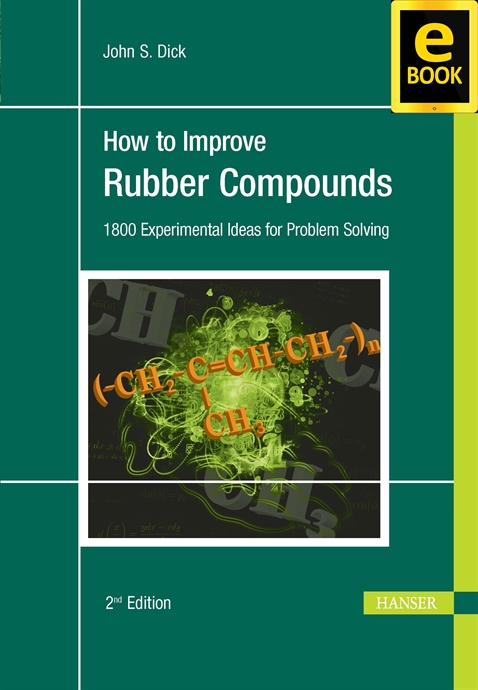Solving Problems in Rubber Compounding and Processing
Course description
Time: 8:00 AM - 4:00 PM
Location: 240 South Forge Street, Akron, Ohio 44325
Classroom 217 (Located inside the National Polymer Innovation Center)
Cost:
$1,250 USD
CEU's: 0.8
Instructor: John Dick
Course Overview
This course is crucial for anyone in the rubber compounding field. It provides an in-depth look at processing problems in mixing, extrusion, calendering and molding. Statistics and methodologies for solving factory problems and case studies are covered as well. Participant’s current processing problems can be discussed with the instructor. The course includes a copy of John Dick's book, How to Improve Rubber Compounds (Hanser Publications).
Course textbook (eBook PDF):

How to Improve Rubber Compounds - 2nd Edition (eBook PDF) by John Dick
Instructor Biography:
 John S. Dick, a senior rubber scientist with Alpha Technologies, has over thirty years of experience in the rubber industry. Mr. Dick has authored over 50 journal and magazine publications and four books on polymer technology. He received the Monsanto Master Technical Service Award in 1994, the ACS Rubber Division Best Paper Award in 1995 and a University of Akron Appreciation Award in 1998 for Teaching Polymer Compounding Courses in their Continuing Education Program. He is a Fellow of ASTM International receiving the Award of Merit in 1990. In addition, he has represented the United States as a delegate to the ISO for the last 20 years. He was appointed in 1992 to be Leader of the U.S. Delegation to ISO TC-45 on Rubber. Mr. Dick teaches rubber technology courses at both University of Akron and University of Wisconsin continuing education departments. He received his B.S. degree from Virginia Polytechnic Institute in 1970 and an M.A. from the University of Akron in 1979.
John S. Dick, a senior rubber scientist with Alpha Technologies, has over thirty years of experience in the rubber industry. Mr. Dick has authored over 50 journal and magazine publications and four books on polymer technology. He received the Monsanto Master Technical Service Award in 1994, the ACS Rubber Division Best Paper Award in 1995 and a University of Akron Appreciation Award in 1998 for Teaching Polymer Compounding Courses in their Continuing Education Program. He is a Fellow of ASTM International receiving the Award of Merit in 1990. In addition, he has represented the United States as a delegate to the ISO for the last 20 years. He was appointed in 1992 to be Leader of the U.S. Delegation to ISO TC-45 on Rubber. Mr. Dick teaches rubber technology courses at both University of Akron and University of Wisconsin continuing education departments. He received his B.S. degree from Virginia Polytechnic Institute in 1970 and an M.A. from the University of Akron in 1979.
Introduction to Factory Problems
- Plant receiving area
- Cold flow
- Stability of pre-powdered blends
Mixing
- Quality of mix
- Uncured elasticity (nerviness)
- Viscosity
- Dispersion
- Bloom
- Green strength
- Tackiness
- Stickiness
- Lump-mill bagging
- Mill back rolling
Extrusion
- Die swell
- Extrusion rate
- Appearance (surface smoothness of extrudate)
- Shear thinning
Calender Release
- Blisters
- Calender release
Molding
- Mold release
- Mold filling
- Non-fills
- Porosity
- Shrinkage of the cured part
- Backrinding
Statistics and Methodologies for Solving Factory Problems
- Basic statistical methods to identify special causes of variation
- Important principles of Statistical Process Control
- Random variation vs. special causes
- Establishing control limits and specification limits
- Methods to detect special causes of variation
Corrective Actions in the Short Term
- Develop a SOP for taking corrective actions for short-term problems
- Develop a strategy for establishing long-term solutions to chronic problems
- Brainstorming for solutions to problems
- Cause and effect diagrams
Six Sigma Techniques for Solving Chronic Rubber Factory Problems
- Methodology
- Statistical methods
- Examples of success in the rubber industry
Nature and Techniques for Solving Problems in Rubber and Compounding and Processing
- Changing one variable at a time techniques for improvement of a rubber compound
- Advantages and disadvantages
- Applying a Design of Experiment
- Advantages and disadvantages
- Interactions
- Multiple response interactions of compound properties
- Chemical interactions of compounding ingredients
Case Studies of Rubber Compounding and Processing Problems
Different case studies that include processing and compounding problems will be discussed and reviewed in interactive groups. Then overall discussions will take place to discuss possible solutions and methodologies.
The course textbook, How to Improve Rubber Compounds, will be used throughout the course and during exercises.
*** Please note, each row and course# listed below is a separate, complete course. ***
